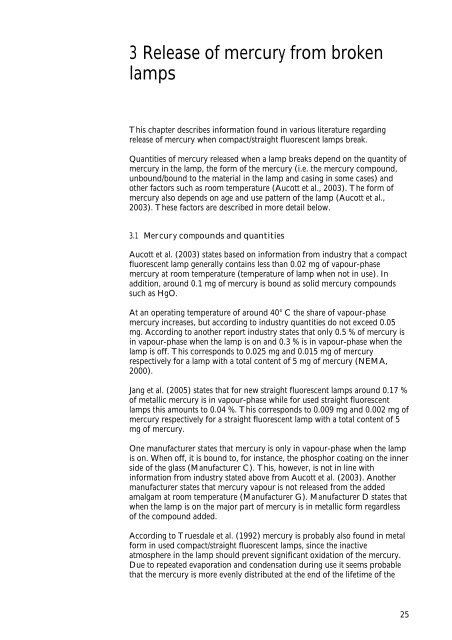No. 104 - Miljøstyrelsen
No. 104 - Miljøstyrelsen
No. 104 - Miljøstyrelsen
You also want an ePaper? Increase the reach of your titles
YUMPU automatically turns print PDFs into web optimized ePapers that Google loves.
3 Release of mercury from broken<br />
lamps<br />
This chapter describes information found in various literature regarding<br />
release of mercury when compact/straight fluorescent lamps break.<br />
Quantities of mercury released when a lamp breaks depend on the quantity of<br />
mercury in the lamp, the form of the mercury (i.e. the mercury compound,<br />
unbound/bound to the material in the lamp and casing in some cases) and<br />
other factors such as room temperature (Aucott et al., 2003). The form of<br />
mercury also depends on age and use pattern of the lamp (Aucott et al.,<br />
2003). These factors are described in more detail below.<br />
3.1 Mercury compounds and quantities<br />
Aucott et al. (2003) states based on information from industry that a compact<br />
fluorescent lamp generally contains less than 0.02 mg of vapour-phase<br />
mercury at room temperature (temperature of lamp when not in use). In<br />
addition, around 0.1 mg of mercury is bound as solid mercury compounds<br />
such as HgO.<br />
At an operating temperature of around 40° C the share of vapour-phase<br />
mercury increases, but according to industry quantities do not exceed 0.05<br />
mg. According to another report industry states that only 0.5 % of mercury is<br />
in vapour-phase when the lamp is on and 0.3 % is in vapour-phase when the<br />
lamp is off. This corresponds to 0.025 mg and 0.015 mg of mercury<br />
respectively for a lamp with a total content of 5 mg of mercury (NEMA,<br />
2000).<br />
Jang et al. (2005) states that for new straight fluorescent lamps around 0.17 %<br />
of metallic mercury is in vapour-phase while for used straight fluorescent<br />
lamps this amounts to 0.04 %. This corresponds to 0.009 mg and 0.002 mg of<br />
mercury respectively for a straight fluorescent lamp with a total content of 5<br />
mg of mercury.<br />
One manufacturer states that mercury is only in vapour-phase when the lamp<br />
is on. When off, it is bound to, for instance, the phosphor coating on the inner<br />
side of the glass (Manufacturer C). This, however, is not in line with<br />
information from industry stated above from Aucott et al. (2003). Another<br />
manufacturer states that mercury vapour is not released from the added<br />
amalgam at room temperature (Manufacturer G). Manufacturer D states that<br />
when the lamp is on the major part of mercury is in metallic form regardless<br />
of the compound added.<br />
According to Truesdale et al. (1992) mercury is probably also found in metal<br />
form in used compact/straight fluorescent lamps, since the inactive<br />
atmosphere in the lamp should prevent significant oxidation of the mercury.<br />
Due to repeated evaporation and condensation during use it seems probable<br />
that the mercury is more evenly distributed at the end of the lifetime of the<br />
25

















